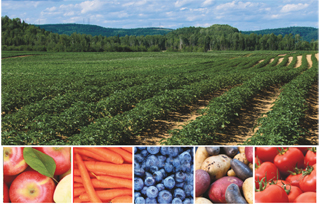“We did have a little bit of late blight in Alberta this year, but it was quite a bit less than the previous year,” comments Hochstein. Fortunately, the Potato Growers of Alberta recently created an education program to inform growers, garden store owners, and the general public about late blight and teach them how to prevent it. “That made a big difference,” he adds.
For the 2014-15 season, Hochstein expects acreage and production to remain pretty much the same, although he does see potential growth in Alberta’s fresh potato acreage which has grown the last two or three years, a trend he expects to continue.
In addition to potatoes, the province also grows sweet corn, carrots, cabbage, beets, peas, and pumpkins as well as a small amount of Saskatoon berries, strawberries, and raspberries. According to Statistics Canada, Alberta’s overall vegetable sales continue to rise.
British Columbia
Nestled between the Pacific Ocean and the Rocky Mountains, British Columbia is Canada’s westernmost and third largest province at 364,764 square miles. It features a wide array of topographies, from mountains and coastland to plains and fjords.
Thanks to British Columbia’s diverse climates and fertile soil, growers in the province produce a variety of fresh fruits and vegetables. Mushrooms are a major crop; more than 35 percent of all Canadian mushrooms are grown there. Berries, wine grapes, tree fruit, and nuts are also top crops, grown on more than 56,834 acres of farmland, which helped the province become Canada’s second highest fruit and nut producer, valued at more than $300 million annually.
British Columbia is also Canada’s largest producer for several individual commodities such as blueberries, sweet cherries, raspberries, pears, and apricots, and the second largest producer of cranberries, grapes, peaches, strawberries, plums/prunes, and nectarines for 2013. The province is also ideally situated for exports, shipping its fruit and nuts to nearly three dozen different markets worldwide.
The Okanagan Valley in southwest British Columbia is home to most of the province’s tree fruit orchards. Apples and sweet cherries are the two largest tree-fruit crops, and cherry production area has expanded significantly over the past few years. Growers produced Canada’s second largest tree fruit crop ever in 2013, and suppliers had high hopes for a repeat in 2015, since 2014 totals were affected by severe weather.



